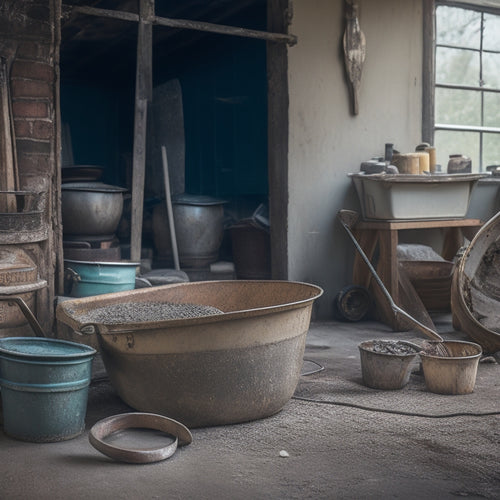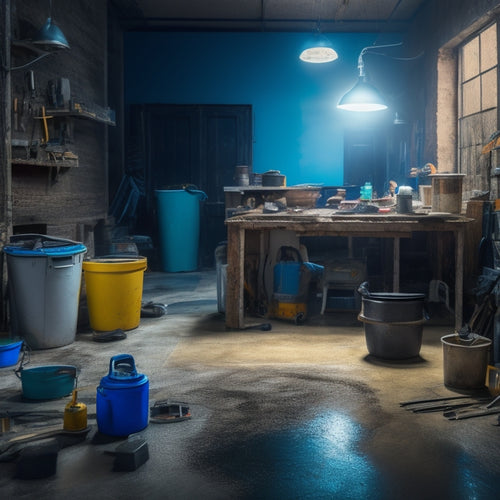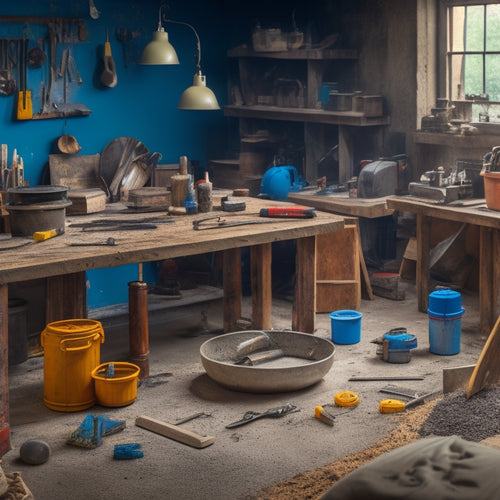
10 Must-Have Tools for Concrete House Construction
Share
When building a concrete house, you'll need specialized tools to guarantee a strong foundation, proper mixing, and precise finishing. Start with backhoes, trenching shovels, and rock saws for foundation digging and excavation. Next, invest in concrete mixing and pumping equipment, formwork, and shuttering systems. Reinforcement tools like cutters, benders, and straighteners are also essential. Additionally, you'll need concrete finishing tools like bull floats, darbies, and power trowels, as well as equipment for compaction, vibration, curing, and sealing. Don't forget safety gear, measuring devices, and cleaning tools to guarantee a successful project that meets your design specifications, and to uncover more critical details that will help you execute your project flawlessly.
Key Takeaways
• Foundation digging and excavation tools, such as backhoes, trenching shovels, and rock saws, are crucial for concrete house construction.
• Concrete mixing and pumping equipment, including mix design optimization and pumping system efficiency, are essential for achieving the desired consistency and strength.
• Formwork and shuttering systems, comprising traditional timber, modular, and insulated concrete forms, are vital for shaping and holding concrete in place.
• Reinforcement and steel fixing tools, such as cutters, benders, and straighteners, are necessary for efficiently shaping and securing rebar.
• Concrete finishing and smoothening tools, including tamping tools, power trowels, and concrete sealers, are required to achieve a high-quality finish and ensure structural integrity.
Foundation Digging and Excavation Tools
You'll need a range of specialized tools to dig and excavate the foundation of your concrete house, including backhoes, trenching shovels, and rock saws that can efficiently break through hard soil and rock formations.
These excavation techniques require careful planning and execution to guarantee trench safety and prevent accidents.
Backhoes, with their hydraulic arms and digging buckets, are ideal for digging deep trenches and foundations.
Trenching shovels, on the other hand, are perfect for manual excavation in tight spaces.
Rock saws, equipped with diamond-tipped blades, can cut through hard rock and soil with ease.
When operating these tools, it's crucial to follow strict safety protocols, such as wearing personal protective equipment, assuring stable ground conditions, and maintaining clear communication with your team.
Concrete Mixing and Pumping Equipment
As you move on to concrete mixing and pumping, you'll need to focus on optimizing your mix design to achieve the desired consistency and strength.
You'll also want to guarantee your pumping system is running at peak efficiency to minimize downtime and reduce labor costs.
Mix Design Optimization
Optimizing mix design is essential in concrete house construction, and it begins with selecting the right concrete mixing and pumping equipment to guarantee consistent, high-quality mixes.
You'll want to take into account factors like material selection, batch size, and mixing time to make certain your mix design meets the project's specific requirements. When selecting materials, you'll need to think about the type and proportion of cement, aggregate, and admixtures to achieve the desired strength, workability, and durability.
You'll also need to take into account the mixing process itself, including the type of mixer, mixing speed, and mixing time. This is where advanced mixing technologies, such as twin-shaft mixers or planetary mixers, can make a significant difference.
Pumping System Efficiency
With a well-designed mix in place, the next essential step is to guarantee that your pumping system can efficiently transport the concrete to the point of placement. This is where the right concrete pumping equipment comes into play.
You'll want to invest in a system that secures peak pump performance, minimizing downtime and maximizing productivity. This means selecting equipment with advanced features such as real-time pressure monitoring, automatic priming, and adjustable flow rates.
Regular system maintenance is also vital to maintain efficiency and extend the lifespan of your equipment. This includes routine cleaning, lubrication, and replacement of wear parts.
By prioritizing pumping system efficiency, you'll be able to pump concrete faster, farther, and with greater accuracy. This, in turn, will enable you to complete projects on time, reduce labor costs, and improve overall quality.
Don't compromise on pumping system efficiency – it's the key to revealing the full potential of your concrete house construction project.
Formwork and Shuttering Systems
You'll need to select a suitable formwork and shuttering system to shape and hold your concrete in place during the construction process. This system consists of molds or frames that give your concrete its desired shape and hold it until it sets.
There are various formwork types to choose from, including traditional timber, modular, and insulated concrete forms. Each type has its advantages and disadvantages, so it's crucial to select the one that suits your project's specific needs.
When it comes to shuttering materials, you'll have options like steel, aluminum, and wood. Steel shuttering is durable and can be reused multiple times, making it a cost-effective option. Aluminum shuttering, on the other hand, is lightweight and corrosion-resistant, making it ideal for complex structures. Wooden shuttering is a popular choice for its ease of use and affordability.
Regardless of the material you choose, verify it's compatible with your formwork type and meets the required strength and durability standards. A well-designed formwork and shuttering system will help you achieve a high-quality concrete finish and reduce construction time.
Reinforcement and Steel Fixing Tools
As you commence your concrete house construction project, you'll need to guarantee that your reinforcement and steel fixing tools are up to par.
Six critical tools are essential for guaranteeing the structural integrity of your concrete house: cutters, benders, straighteners, tie-wire cutters, and bar chairs. These tools will help you to accurately shape, cut, and secure your rebar, ensuring that your concrete structure can withstand the forces of nature.
When it comes to steel bar bending, you'll need a reliable bender that can handle the task efficiently. Look for a tool that can bend bars to precise angles, ensuring that your rebar is accurately shaped to fit your structure's design.
For rebar tying, a high-quality tie-wire cutter is a must-have. This tool will enable you to quickly and easily cut tie wires to the correct length, ensuring a secure hold on your rebar.
Concrete Finishing and Smoothening
Precision matters in concrete finishing and smoothening, where even slight imperfections can compromise the structural integrity and aesthetic appeal of your concrete house.
You'll need the right tools to achieve a smooth, even finish that meets your design standards. For a high-gloss finish, you'll require specialized finishing techniques and surface treatments.
Invest in a set of tamping tools, such as bull floats and darbies, to eliminate air pockets and achieve a uniform surface. Next, use a power trowel or a ride-on trowel to apply the desired finish, whether it's a high-gloss polish or a textured, matte look.
Don't forget to apply a concrete sealer or hardener to protect your concrete from the elements and enhance its durability.
By mastering these finishing techniques and surface treatments, you'll be able to achieve a professional-grade finish that will elevate your concrete house's aesthetic appeal and structural integrity.
With the right tools and techniques, you'll be able to create a stunning, long-lasting concrete surface that meets your design vision.
Compaction and Vibration Equipment
When building a concrete house, you'll need to guarantee the soil is compacted properly to create a stable foundation.
You'll have to choose the right compaction method and equipment for the job, considering factors like soil type and moisture levels.
In this section, you'll learn about the different soil compaction methods, vibratory plate compactors, and hand-held rammers that can help you get the job done effectively.
Soil Compaction Methods
You'll typically begin soil compaction by selecting the right equipment for the job, which often includes a combination of compaction and vibration tools. The type of soil you're working with will heavily influence your equipment choices. For instance, clay-based soils require more intense compaction to achieve ideal density, whereas sandy soils may only need a lighter touch. Understanding the soil types you're dealing with is vital in choosing the right compaction techniques.
You'll need to take into account the moisture content of the soil, as well. If the soil is too wet, it may not compact properly, leading to weak foundations. In such cases, you may need to use specialized equipment designed for wet soil compaction.
There are various compaction techniques to choose from, including impact compaction, kneading compaction, and compression compaction. Each technique has its own strengths and weaknesses, and selecting the right one depends on the specific project requirements.
Vibratory Plate Compactors
Selecting the right compaction equipment, like vibratory plate compactors, is key to achieving the ideal density and stability required for a solid concrete house foundation.
You'll find that vibratory plate compactors are a popular choice among contractors due to their high efficiency and versatility. These machines use a vibrating plate to compact soil, gravel, and other materials, allowing for precise control over the compaction process.
When choosing a vibratory plate compactor, you'll need to evaluate factors such as plate size, vibration frequency, and centrifugal force.
There are several compactor types to choose from, including lightweight, mid-size, and heavy-duty models, each suited for specific applications. For instance, lightweight compactors are ideal for small to medium-sized projects, while heavy-duty models are better suited for large-scale construction sites.
Hand Held Rammers
Operating in tight spaces or maneuvering through irregular terrain, hand held rammers prove invaluable for compacting and vibrating materials in areas inaccessible to larger equipment.
You'll appreciate the versatility of these tools, which enable you to tackle compacting tasks in corners, edges, and other hard-to-reach areas. Hand held rammers' benefits include their lightweight design, ease of use, and ability to deliver precise control over compaction forces.
When using hand held rammers, it's crucial to employ proper operating techniques to achieve the best results. Start by selecting the correct rammer weight and frequency for your specific application.
Next, position yourself comfortably, with a firm stance and a secure grip on the handle. Apply gentle to moderate pressure, depending on the material, and maintain a consistent pace to guarantee even compaction.
As you work, pay attention to the rammer's vibrations, adjusting your technique as needed to achieve the desired density. By mastering hand held rammers' operating techniques, you'll be able to efficiently compact materials, even in the most challenging environments.
Curing and Sealing Tools and Materials
Curing compounds, sealers, and specialized tools are essential for protecting and enhancing the durability of your newly poured concrete surfaces.
When it comes to curing techniques, you'll need to apply a curing compound to prevent water loss and promote hydration. This can be done using spray, brush, or roller applications, depending on the type of compound and surface finish desired.
For sealing agents, you'll want to choose a product that complements your concrete's finish and desired level of protection. Acrylic, polyurethane, and epoxy-based sealers are popular options, each offering varying degrees of durability and aesthetic appeal.
In addition to these materials, you'll need specialized tools to guarantee a successful curing and sealing process. Curing blankets, spray nozzles, and micro-fiber rollers are must-haves for efficient and effective application.
Don't forget to invest in a reliable temperature and humidity gauge to monitor environmental conditions, which can greatly impact your concrete's curing process.
Safety and Protection Gear Essentials
As you prepare to tackle your concrete house construction project, you'll need to outfit yourself with essential safety and protection gear to prevent injuries and guarantee a hazard-free working environment. This includes investing in high-quality protective equipment, such as hard hats, safety glasses, earplugs, and respirators, to shield yourself from falling objects, debris, and hazardous materials.
Don't forget to wear steel-toed boots, gloves, and high-visibility vests to protect your feet, hands, and body from potential hazards.
It's also vital to undergo safety training to learn how to handle heavy machinery, operate power tools safely, and respond to emergencies. This training will equip you with the knowledge and skills to identify potential hazards, mitigate risks, and take corrective action in case of an accident.
Additionally, make sure to regularly inspect your equipment and tools to verify they're in good working condition.
Measuring and Testing Devices
To guarantee accurate concrete mixing and placement, you'll need to equip yourself with precision measuring and testing devices, including digital scales, slump cones, and concrete test hammers. These tools will confirm that your concrete meets the required strength and consistency standards.
Digital scales are essential for measuring the exact weight of cement, sand, and aggregate, while slump cones help you determine the workability of the concrete. Concrete test hammers, on the other hand, measure the surface hardness of the concrete.
In addition to these devices, you'll also need tape measures and laser levels to confirm accurate layout and leveling of the concrete structure. Tape measures will help you measure distances, widths, and heights, while laser levels will ensure that your surfaces are perfectly level and plumb.
These tools will help you achieve precise results, reduce errors, and save time. By investing in these measuring and testing devices, you'll be able to construct a high-quality concrete house that meets the required building codes and standards.
Cleaning and Maintenance Tools
Cleaning and Maintenance Tools
Equip yourself with a range of cleaning and maintenance tools, including wire brushes, scrubbers, and pressure washers, to remove dirt, grime, and excess concrete from your tools and equipment. This is vital to guarantee your tools remain in good condition, prolonging their lifespan and maintaining their accuracy. Effective cleaning techniques will also prevent the spread of contamination and corrosion.
To establish a maintenance schedule, consider the frequency of use and the type of tool or equipment. For instance, daily cleaning may be necessary for high-use tools, while weekly or monthly cleaning may be sufficient for less frequently used equipment.
| Tool/Equipment | Recommended Cleaning Frequency |
| Wire Brushes | Daily/After each use |
| Scrubbers | Weekly |
| Pressure Washers | Monthly/After each project |
| Concrete Mixers | Daily/After each use |
| Trowels | Weekly |
Frequently Asked Questions
Can I Use Regular Gloves for Concrete Construction Work?
You can't use regular gloves for concrete construction work; instead, opt for heavy-duty, puncture-resistant gloves that meet specific safety standards, such as ANSI/ISEA 105 or EN 388, to guarantee protection from cuts, abrasions, and chemical exposure.
How Often Should I Inspect My Construction Tools for Damage?
You'll find that regular tool inspections are essential, as neglect can lead to accidents and delays. Aim to inspect your tools daily, and dedicate time each week to thorough examinations, ensuring ideal tool maintenance and extending their lifespan.
Are There Any Eco-Friendly Concrete Construction Options Available?
You're looking for eco-friendly concrete construction options, and yes, there are several sustainable materials and green technologies available, such as recycled aggregate, fly ash, and self-healing concrete, which reduce environmental impact while maintaining structural integrity.
Can I Reuse Concrete Finishing Tools After Cleaning?
As you echo the wisdom of Da Vinci, ' Details make the difference,' you'll find that properly cleaning and maintaining your concrete finishing tools guarantees their reuse, and it's all about mastering advanced concrete tool maintenance and cutting-edge cleaning techniques.
What Is the Ideal Temperature for Concrete Curing?
When you're working with concrete, you'll find that the perfect temperature for best curing is between 50°F and 75°F, as temperature effects can greatly impact strength development, so make sure you're within this range for the best results.
Conclusion
As you stand back to admire your newly constructed concrete house, remember that it was the culmination of meticulous planning, precision, and the right tools.
On one hand, the sleek, modern design and sturdy structure evoke a sense of pride and accomplishment.
On the other hand, the grueling labor, sweat, and tears that went into building it are a tribute to the importance of having the right tools for the job.
Related Posts
-

Top Tools for Mixing Concrete at Home
When mixing concrete at home, you'll need a range of tools to guarantee a successful operation. Start with essential ...
-

Essential Tools for Epoxy Concrete Floor Repair
You'll need a thorough arsenal of specialized tools to guarantee a successful epoxy concrete floor repair. Floor prep...
-

Budget-Friendly Tools for DIY Decorative Concrete Profiling
You can achieve professional-grade decorative concrete results on a budget by investing in the right combination of e...


